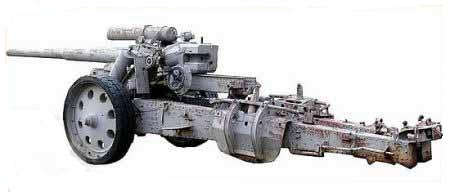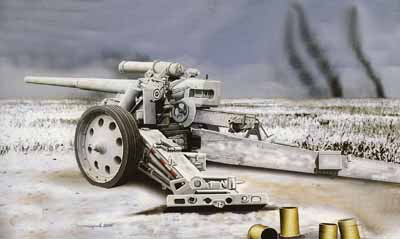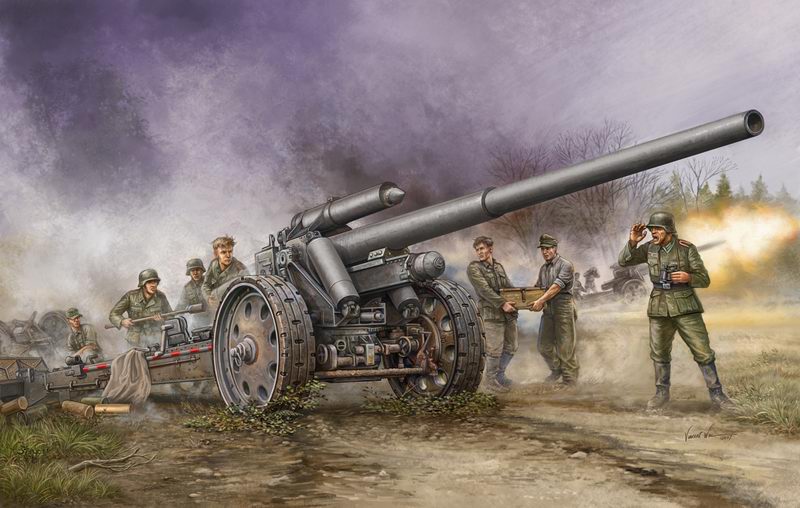


Sk 18 10,5 cm (Draguignan )
English Translation
 |
L’une des priorités de l'après-Première Guerre Mondiale ,pour le nouveau parc d'artillerie allemand était de combler les pertes dues à cette guerre . il fallait donc mettre au point un nouveau canon à longue portée pour son utilisation par les corps d'artillerie de campagne, plutôt que les batteries
Ce projet a été l'un des tout premiers à être mis au point en secret par l'industrie allemande d'armement en 1926, avec deux constructeurs Krupp et Rheinmetall qui ont construit un prototype en de 1930 qui sera soumis à ces tests sérieux rapidement
Mais l’Etat Major ne se décider et un compromis est donc choisi à la fin. Avec le choix de Rheinmetall pour le canon et de Krupp pour l affut
Cet affut Krupp est destiné à devenir l'un des plus utilisés dans le parc d’artillerie allemand Il sera d’ailleurs utilisé pour les canon plus lourds comme le les obusiers 15 cm s FH 18
Il a été mis en service en corps de troupe en 1934 sous le nom 10,5 cm K 18 et il fut le canon standard pour l artillerie de campagne .
Mais rapidement, il semble que le choix du calibre de 105 mm pour une arme de ce type a été un choix malheureux
Le canon était trop lourd pour le projectile tiré et de plus l’obusier de 15cm tirer un obus de même puissance et capacité pour un poids de canon sensiblement identique
De plus, lors de sa mise en service, l'armée allemande, commençait sa transformation (en partie) sur la mécanisation
Le canon était trop lourd pour un équipage de chevaux ce qui entraine pour la traction à séparer le fardeau en deux (bizarre pour un canon de 10.5cm)
Avec l'introduction des Half tracks il fut possible de tracter la pièce en seul fardeau mais ce type d armement n’avait plus la priorité et il fut produit en faible quantité
Afin d’augmenter la puissance du K 18 il fut décider de toute façon il n y avait pas d’autre choix d’allonger la longueur du tube Il passa donc IV 52 to IV 60
Les premiers modèles améliorés furent prêt en 1941 et il est connu sous le nom de 10.5 cm K 18/40 mais il ne fut mis en production que beaucoup plus tard sous le nom de 10,5 cm K 42, mais très peu ont été produits
En 1941, les faiblesses du K 18 et de sa dernière version sont connues mais il lui reste un rôle à jouer là où son poids et son encombrement ne pose pas trop de problème à savoir la défense côtière
Le Mur de l'Atlantique (à l'époque en cours de construction) a besoin d’une importante quantité d’arme et le K18 a été attribuée à ce rôle statique
En terme de défense côtière ce canon un avantage considérable avec sa longue portée même si le poids du projectile reste plutôt faible
On fabriqua pour lui des munitions plus puissance et une nouvelle gamme de munitions pour le tir sur des cible maritime avec un marqueur spécifique en bout
 |
 |
Caractéristiques
Production 1934–1943
Calibre 105mm
Poids 5,642 kg
Longueur canon 5.46 m L/52
Obus en 3 parties
Site 0° to +48°
Cadence de tir 6
V° 835 m/s
Portée 19,075 m
 |
Autre photoscope (Other Walk Around ) 1
Sk 18 10,5 cm (Draguignan)
 |
Among post war requirements of the new German artillery park to replace the lost relies of WW1 was that for a new long range gun for use by corps rather field artillery batteries
The project was one of the very first put to the underground German armament industry and in 1926 both Krupp an Rheinmetall had produced specimen design and by 1930 both were ready with prototype hardware
As it turned out the German army could not decide which design to approve ans at the end a compromised was accepting with the Rheinmetall barrel and the Krupp carriage
The Krupp carriage was destined to become one of the most used of all the German artillery carriages or it was the same hat used on the larger 15 cm s FH 18 howitzer series
It was in 1934 when the first gun reached the troops and he was know as the 10.5 cm K 18 and was the standard weapon of the medium artillery batteries
But quickly it appear what the choise of the 105 mm caliber for a medium gun was was an unhappy one
The gun was to heavy for the weigth of the projectile fired The larger 150mm howitzer fire a much more efficient projectile over almost the same range and at no great increase in weapon weight
There was also another snag when the K18 entered in service it was a time when the German army become his transformation ( partially ) on mechanization
The gun weighed too much for one horse team to tackle so the barrel and carnage had to be towed as separate loads which was a bit much for a 105 mm gun
With the introduction latter of half tracked tractor it was enabled to towe the piece in one load but n ow the K 18 was a very low production priority
In order to make the K 18 more powerfull German Staff planned for an increase in range
There was no way to produce this increase without lengthening the length of the barrel from the original IV 52 to IV 60
The first of this improved models was ready in 1941 and was know as 10.5 cm K 18/40 but it was not put into poruction until much later when designation had been changed in 10.5 cm K 42 Very few were produced
By 1941 the disadvantage of the K 18 and its latter versions had been recognized but there remained a role for them where their weight and their bulk would be of a relatively minor disadvantage namely in coastal defense
Weapons for the Atlantic wall (at that time under construction ) were in great demand and short supply so the K18 was assigned to that relatively static role
As a costal defense weapon the piece ha a considerable advantage in its long range even if the projectile weight as still rather low
To enable it be used to greater advantage when firing at marine targets a new range of ammunitions was introduced among which was a special sea marker shell for ranging purpose
 |
 |
Technical data
Production 1934–1943
Caliber 105mm
Weigth 5,642 kg
Length with barrel
Shell separate-loading, cased charge (3 charges
Site 0° to +48°
Tate of fire 6
V° 835 m/s
Range 19,075 m
 |